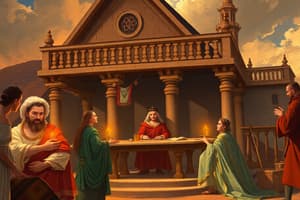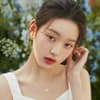Podcast
Questions and Answers
What aspect of Renaissance sculptures distinguishes them from previous styles?
What aspect of Renaissance sculptures distinguishes them from previous styles?
- They focused mainly on religious themes.
- Facial expression and body movements make them more life-like. (correct)
- They often utilized abstract forms.
- They are less realistic than earlier sculptures.
Which artist is known for the sculpture 'The Pieta'?
Which artist is known for the sculpture 'The Pieta'?
- Leonardo da Vinci
- Michelangelo (correct)
- Donatello
- Raphael
Which architectural feature is commonly associated with Renaissance architecture?
Which architectural feature is commonly associated with Renaissance architecture?
- Tall pointed towers
- Flying buttresses
- Domes (correct)
- Stained glass windows
What concept did Copernicus introduce during the Renaissance regarding the structure of the universe?
What concept did Copernicus introduce during the Renaissance regarding the structure of the universe?
Which of the following elements defines Gothic architecture as opposed to Renaissance architecture?
Which of the following elements defines Gothic architecture as opposed to Renaissance architecture?
Which of these features is a notable characteristic of Renaissance architecture?
Which of these features is a notable characteristic of Renaissance architecture?
What is one of the main influences on Renaissance architecture?
What is one of the main influences on Renaissance architecture?
Which of the following figures is not known for sculpting during the Renaissance?
Which of the following figures is not known for sculpting during the Renaissance?
What does the term 'Renaissance' mean?
What does the term 'Renaissance' mean?
Which period is considered the Renaissance?
Which period is considered the Renaissance?
What was one major cause of the Renaissance?
What was one major cause of the Renaissance?
How did the Renaissance challenge traditional ideas?
How did the Renaissance challenge traditional ideas?
Which civilization was revived during the Renaissance?
Which civilization was revived during the Renaissance?
What effect did the decline of feudalism have on society during the Renaissance?
What effect did the decline of feudalism have on society during the Renaissance?
Which of the following represents the rise of humanism during the Renaissance?
Which of the following represents the rise of humanism during the Renaissance?
What social change contributed to the flourishing of art and learning during the Renaissance?
What social change contributed to the flourishing of art and learning during the Renaissance?
What was a significant consequence of the Crusades on East-West interactions?
What was a significant consequence of the Crusades on East-West interactions?
How did the fall of Constantinople in 1453 affect European scholarship?
How did the fall of Constantinople in 1453 affect European scholarship?
Which city was NOT mentioned as benefiting from trade between Europe and the East?
Which city was NOT mentioned as benefiting from trade between Europe and the East?
What innovation by Gutenberg had a major impact on the spread of ideas during the Renaissance?
What innovation by Gutenberg had a major impact on the spread of ideas during the Renaissance?
Which painting technique became more prevalent during the Renaissance?
Which painting technique became more prevalent during the Renaissance?
What role did wealthy merchants play in the advancement of the arts during the Renaissance?
What role did wealthy merchants play in the advancement of the arts during the Renaissance?
Which of the following reflects a shift in themes seen in Renaissance art compared to the medieval period?
Which of the following reflects a shift in themes seen in Renaissance art compared to the medieval period?
What was one of the notable achievements of the Renaissance in higher education?
What was one of the notable achievements of the Renaissance in higher education?
Flashcards
Islamic Golden Age
Islamic Golden Age
A period from the 9th to 14th centuries where Arab civilization excelled in science, mathematics, and philosophy.
Crusades
Crusades
A series of military campaigns by European Christians against Muslims in the East, mainly to recapture Jerusalem.
Renaissance
Renaissance
A period of renewed interest in classical learning and culture in Europe, starting in the 14th century.
Printing Technology
Printing Technology
Signup and view all the flashcards
Increased Trade
Increased Trade
Signup and view all the flashcards
Rise of Universities
Rise of Universities
Signup and view all the flashcards
Renaissance Art
Renaissance Art
Signup and view all the flashcards
Declining Church Influence
Declining Church Influence
Signup and view all the flashcards
Greco-Roman Civilization
Greco-Roman Civilization
Signup and view all the flashcards
Humanism
Humanism
Signup and view all the flashcards
Secular
Secular
Signup and view all the flashcards
Scientific Method
Scientific Method
Signup and view all the flashcards
Black Death
Black Death
Signup and view all the flashcards
Decline of Feudalism
Decline of Feudalism
Signup and view all the flashcards
Innovation in the Renaissance
Innovation in the Renaissance
Signup and view all the flashcards
Renaissance Sculpture Inspiration
Renaissance Sculpture Inspiration
Signup and view all the flashcards
Renaissance Sculpture Characteristics
Renaissance Sculpture Characteristics
Signup and view all the flashcards
Renaissance Architecture Influence
Renaissance Architecture Influence
Signup and view all the flashcards
Renaissance vs. Medieval Architecture
Renaissance vs. Medieval Architecture
Signup and view all the flashcards
Renaissance Astronomy: Geocentrism
Renaissance Astronomy: Geocentrism
Signup and view all the flashcards
Renaissance Astronomy: Heliocentrism
Renaissance Astronomy: Heliocentrism
Signup and view all the flashcards
Galileo's Role in Heliocentrism
Galileo's Role in Heliocentrism
Signup and view all the flashcards
Church's View on Geocentrism
Church's View on Geocentrism
Signup and view all the flashcards
Study Notes
The Renaissance
- Definition: "Renaissance" means "rebirth" in French. It was a cultural and intellectual movement spanning from the late 14th to the early 17th centuries. The Italian Peninsula was considered its birthplace.
Features of the Renaissance
- Revival of Greco-Roman Civilization: People renewed their interest in the culture of ancient Greece and Rome.
- Rise of Humanism: Europe became more secular (less focused on religion), emphasizing rationality, independent thought, and the scientific method. Traditional ideas held by the Church for centuries were challenged.
- Challenging Tradition: Humanism, as a result of this shift, led to the questioning of traditional ideas and the development of new ideas and inventions.
Causes of the Renaissance
- The Black Death and Decline of Feudalism: The devastating plague in the 14th century led to depopulation and a decline in feudalism. This created opportunities for those who survived, and many rural people moved to cities, promoting economic growth, social change, and the arts.
- Increased Interaction Between East and West: The Crusades and trade facilitated knowledge exchange between Europe and the Middle East, introducing new ideas, philosophies, and technologies. The fall of Constantinople in 1453 led Greek scholars to Italy, bringing ancient knowledge.
- Growth of Cities: Italian cities experienced significant growth thanks to trade, fueling wealth and support for the arts.
- Rise of Universities and Intellectuals: Universities emerged, promoting learning and fostering intellectual growth during the late Middle Ages.
- Printing Technology: Johannes Gutenberg's invention of the printing press revolutionized the spread of ideas and knowledge, allowing books to circulate and be shared much more easily.
- Declining Influence of the Church: While religion remained important, the Renaissance saw a shift in power dynamics, with increased emphasis on human potential and accomplishments.
Major Achievements of the Renaissance
Art
- Painting: Artists focused on diverse themes (not only religion), employed more realistic and three-dimensional techniques, including perspective and shadowing.
- Sculptures: Inspired by the Bible, but Renaissance sculptures were more realistic, emphasizing detailed facial expressions and body movements.
Architecture
- Background: The Renaissance revived Classical Antiquity, drawing heavily from Greco-Roman styles.
- Features: Features like pointed arches which were common in the Medieval Era, were replaced with semi-circular Roman arches, tall towers with domes.
Astronomy
- Medieval Times: The prevailing view was geocentrism (Earth was the center of the universe), supported by the Church.
- Renaissance: Heliocentrism (Sun-centered universe) gained prominence, challenging the Church's view. Copernicus and Galileo were key figures in this shift.
Medical Science
- Medieval Times: Disease was attributed to God's punishment, and dissection of bodies was often prohibited.
- Renaissance: Scientific inquiry into disease and the body increased, leading to more understanding of the human anatomy. Doctors used observation and research, including dissection.
Studying That Suits You
Use AI to generate personalized quizzes and flashcards to suit your learning preferences.





